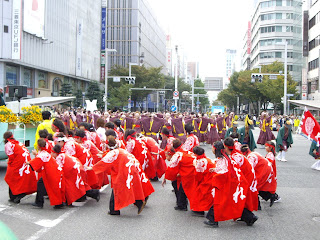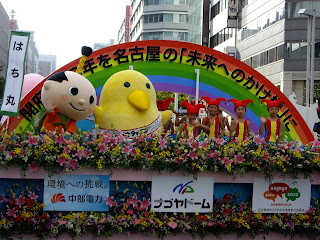Sun up
The sun rises incredibly early here. On the first few mornings when I had to be up for 8am, opening my eyes to blazing sunshine streaming through the curtains had me leaping out of bed for fear of having slept in till midday, only to find my alarm hadn't yet gone off. Evening comes soon too - the sun starts setting around 5pm-ish.
 Cables anyone?
Cables anyone?I don't know if it's because they'd be easier to repair after an earthquake or maybe it's because digging up the road might be too expensive, but there are staggering amounts of cables run throughout the streets around here. This is only in the outskirts though - going to the city centre there are almost none at all.
Please take care!
There's a lot of things in Japan that simply talk at you - the most strange are ambulances, large trucks and escalators, which as far as I can make out simply repeat things along the lines of "This is an escalator. Please take care when stepping on". When vehicles start to talk at you it's hard to stop thinking of political rallies. This is especially "fun" because living very close to a hospital hearing ambulances loudly annouce their arrival in the early hours grates a bit.
Birds in Traffic Lights
Traffic lights will either beep at you when they go green, or they also sometimes chirp at you. When the little chirping speaker is high up on a pole somewhere, it's hard to distinguish it from passing birds and you suddenly feel very sorry for any blind people trying to cross the road.
Milk
There is a huge variety of milk in the supermarkets. So, being the adventurous sort I've been working my way through them all - so far I've had milkish milk, thinner milkish milk, and milk that tastes like it's had cereal floating in it for a while (slightly sugary).
 Good Ideas
Good IdeasJapan seems to be full of these, at least, at face value. For example, the trains stop exactly at marked places, meaning you know where you'll be getting on. Shops have models of the food you'll be ordering so you know what you'll be getting. There are umbrella stands everywhere where you can leave your soaked umbrella outside without someone stealing it. I even found an open book exchange in the subway - simply put down and pick up books as you read through them on your way somewhere. Convenience stores have warm food, microwaves and boiling water available for you to feed yourself well on the go. At supermarkets you pay for your shopping, then take it yourself to a bagging area and bag it up yourself. All-you-can-eat/drink restaurants :) Mobile phones.
Bad Ideas
ATMs have opening hours. The subway stops at midnight, leaving you stranded for the night unless you want to pay an expensive taxi home. Bread and cereal come in small packets, meaning you go through them faster than Pringles. Cheese and sausages are pretty much unobtainable, as are(/were, ish) bananas since some magazine proposed an "Exclusive Banana Diet" which quiet caught the public imagintion at the time and promoted hysterical bulk buying of the things.
Enormous Insects
Enough said really. The worst thing is the noise - because they're all so staggeringly huge the buzz is about two octaves lower, giving them a much more ominous feeling. I was almost hit by a butterfly about the size of a bat the other day - big, black and flapping in your face certainly makes you jump.
 Bins
BinsThere are a lot of these (when you find them - public bins are much more a rariety in Japan). This is because of Japan's harsh recycling program, through which you must divide your rubbish first into Plastic, Paper, PET, Aluminium, Glass, TetraPak and Paper Cartons, then sort the remainder into Burnable and Non-burnable. Each has its own way of being prepared, for example with PET you must remove the label and cap (which go to plastic) then wash it out and crush it. It's actually very interesting to see just how much of what I throw out is plastic.
Gaijin
Being foreign in Japan is certainly an experience. A quote I heard in my second week pretty much summarises it: "But I don't want to be a minority!" It's not so much the fact that you're different, more that Japanese people (in general) think that they 'should' treat you differently, leading to some odd situations. You don't know what to do/how to behave because it's all new, and they don't know what to do differently because you're foreign and treating you normally is discounted for some reason. This isn't helped when you don't understand what they're saying (shop attendants in Japan speak in honorific language, or Keigo, which is the equivalent of a very wordy roundabout Jeeves style of English). It's taken me up to this point to work out when the till people are asking if I want a bag or not. This will almost certainly improve, but it's certainly a defining characteristic of life here initially.
More later...








































